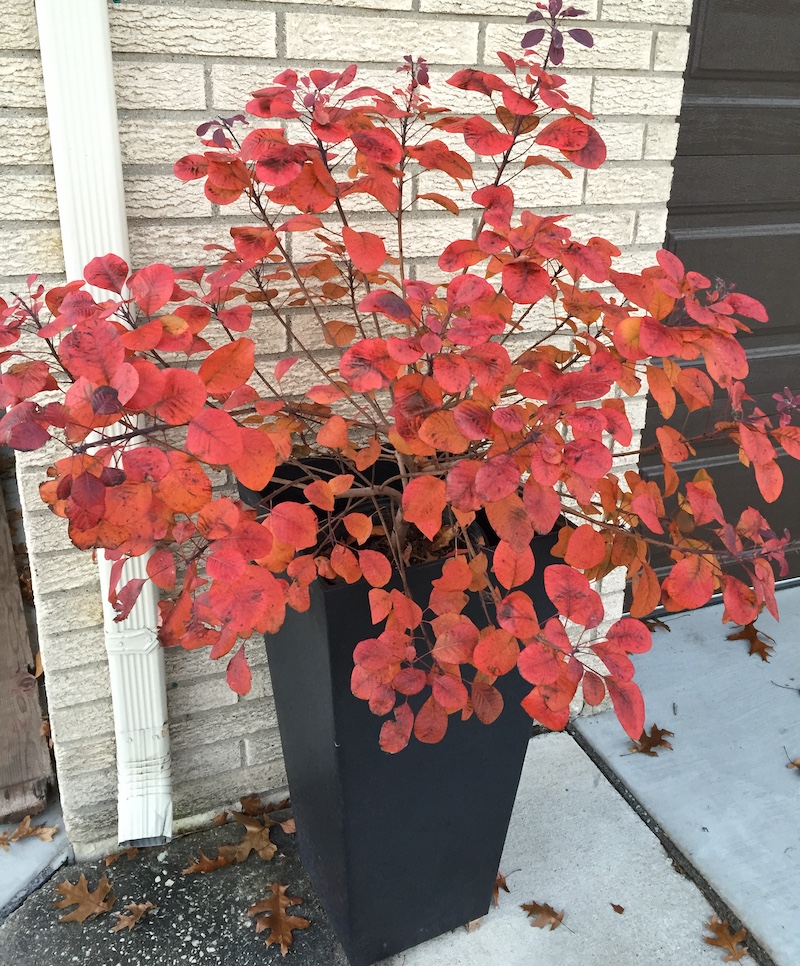Smoke Trees (Cotinus spp.) are ornamental shrubs with wispy, smoke-like flowers and burgundy to blue-green leaves. Their unique shape and color allows these plants to pop in any landscape and add something special to a group of plants, making them an ideal choice in containers. Despite their large size, Smoke Trees can make good container plants. Smoke Trees are hardy in zones 5 through 8, allowing them to survive in large pots as long as they are protected from extreme temperatures in the winter and are watered adequately in the summer.

Planting Smoke Trees in Pots
When planting Smoke Trees in pots, it is important to consider the mature size of the plant, the pot size, and location. Smaller or dwarf varieties are best for containers because they will not need to be transplanted into a larger pot as frequently. Larger varieties may need to end up in the ground to allow them to grow to their full size.
When choosing a pot for your Smoke Tree, take into consideration what plants, if any, you are pairing it with. Choose a pot that is at least a few inches larger than the root ball, with some extra room if you are planting it with companions. Even if your Smoke Tree will eventually grow much larger, avoid planting it into a pot that is too large, as excess soil will hold onto water, potentially damaging the roots. Your pot should also have adequate drainage, as Smoke Trees do not like to have “wet feet”. You may want to use a heavier pot like ceramic or one with a large base to prevent it from tipping over. Smoke Trees need at least 6 hours of sun to thrive, keeping in mind that in warmer regions, more sun means more heat and more frequent watering.
Best Soil For Smoke Trees in Pots
Smoke Trees require good drainage, so it is best to plant them in a fast-draining potting soil. It may even be beneficial to add some organic matter like compost to improve drainage. To prevent the soil from drying out too quickly, you can add mulch or stones to the top of the soil to help retain moisture. When planting the Smoke Tree, only place the root ball as deep as it is in its current pot; do not bury the trunk any deeper as this may lead to health issues.
Caring For Smoke Trees in Planters
When plants are kept in containers, their roots are exposed to more extreme temperatures than if they were planted in the ground. This is why potted plants dry out faster than their in-ground counterparts. Smoke Trees should not be pruned for the first couple years after being planted in a pot.

Watering Smoke Trees in Pots
To keep your Smoke Tree happy, allow the first inch or two of soil to dry out completely before watering deeply until water comes out the drainage holes. In periods of drought and extreme heat, this may be as often as once a day. The size of the pot is also going to impact the frequency of watering, as excess soil will hold onto water longer.
Fertilizing Smoke Trees in Pots
It is not necessary to fertilize Smoke Trees within the first couple of years after being planted in a container. After this time, add a slow-release multi-purpose fertilizer to the soil in the late winter or early spring. Typically, plants in pots need more fertilizer than those in the ground as water passes through the pot more rapidly, but Smoke Trees are not heavy feeders.
Winter Care For Smoke Trees in Pots
In colder regions, move your Smoke Tree into a garage or other protected area to prevent the roots from freezing. Smoke Trees do best when they are allowed to go dormant in the winter, so it is not necessary to bring them indoors with heat and light. Protecting the plant from extreme cold temperatures will also protect their developing bud sites and prevent the container from cracking.
Growing Smoke Trees Indoors
Smoke Trees are full sun perennial trees. They are not suitable for growing indoors as they require at least six hours of full sun. Smoke Trees do best when they go dormant in the winter, so it is not necessary to bring them indoors.
 |
Author Lynn Gusman - Published 7-27-2023 |
